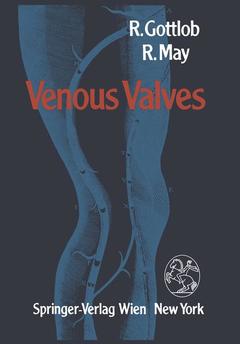Description
Venous Valves, Softcover reprint of the original 1st ed. 1986
Morphology, Function, Radiology, Surgery
Authors: Gottlob R., May R.
Language: English
Subjects for Venous Valves:
Keywords
Bypass; Operation; anatomy; artery; circulation; diagnosis; embryology; inflammation; morphology; noxa; surgery; therapy; transplantation; ultrasound
Approximative price 105.49 €
In Print (Delivery period: 15 days).
Add to cart
Publication date: 01-2012
228 p. · 17x24.4 cm · Paperback
228 p. · 17x24.4 cm · Paperback
Description
/li>Contents
/li>
Venous valves rank among the smallest and most delicate organs of the human and animal bodies - so why devote an entire book to them? We were induced to do so by several reasons. First of all we would point out the clinical significance of venous valves. In the pathogenesis of a number of widespread diseases, such as varicose veins or the post-thrombotic syndrome, venous valves are involved as the underlying cause or at least a factor contributory to the symptoms. According to Taheri et al. these venous diseases occur ten times more frequently than arterial obliterations. Incompetence of venous valves also plays a causal role in varicocele, the most frequent cause of male infertility. But not only pathogenetic reasons induced us to write this book. In more recent times there has been a growing tendency to reconstruct functional valve disorders therapeutically; several surgical methods have been developed, which are critically reviewed in this book. It was our aim to sum up existing knowledge with respect to structure and function of venous valves and to expand that knowl edge by findings of our own. Examinations of semi-thin sections and unilayered en-face preparations have hardly been published so far, and systematic studies of the ultrastructure by electron-microscopy were not to be found in the literature. We are very grateful, therefore, to Dr. Silvana Geleff for having undertaken such a study upon our suggestion.
I. History.- II. Healthy Venous Valves.- 1. Embryology of Venous Valves.- 2. Occurrence and Distribution of Venous Valves.- A. General.- B. Leg and Pelvic Veins.- a) Distribution of Valves in Various Leg Veins.- b) Lawful Regularity of Distribution (“Klappengesetze”).- c) Do Venous Valves Perish During Post-fetal Life?.- d) How Do Valves in Overdilated Veins Perish?.- e) Veins in Other Circulatory Regions.- 3. Anatomy of Venous Valves.- A. Macroscopic Anatomy.- a) Parietal Valves (Pocket Valves).- b) Ostial Valves.- c) Spatial Arrangement of Venous Valves.- B. Histology.- a) Paraffin Sections.- b) Semi-thin Sections.- c) Silver-stained En-face Preparations.- d) Unicellular Flat-Preparations (“Häutchenpräparate”).- e) Electron Microscopy (By S. Gelelf) 53.- 4. Functions of Venous Valves.- A. Hydrodynamic Function.- B. Other Functions of Venous Valves.- C. Methods of Testing the Function of Venous Valves.- a) Clinical Examination.- b) Doppler-Ultrasound Diagnosis.- c) Peripheral Venous-Pressure Measurement (According to May and Kriessmer, 1978).- d) Photoplethysmography (PPG) and Light-Reflection Rheography (LRR).- e) Other Plethysmographic Methods.- f) Functional Testing of Individual Valves of the Femoral Vein.- Summary of Part II.- III. Pathologic Venous Valves.- 1. Pathologic Morphology.- A. Mechanical Lesions, Chemical Noxae.- B. Congenital Absence of Valves.- C. Age-related Changes.- a) In Conventional Paraffin Sections.- b) Age-caused Changes in Endothelium (Monolayered Flat-Preparations).- D. Inflammation of Venous Valves.- E. Venous Valves and the Development of Thrombosis.- F. Thrombosis of Valvular Pockets.- G. Post-thrombotic Changes of Venous Valves.- a) Complete Thrombosis in Paraffin Sections.- b) Incomplete Thrombosis.- c) Venous Valves After Spontaneous Lysis of Experimental Thrombi (En-face Preparations).- H. Valves in Varicose Veins.- a) Macroscopic Findings and Conventional Histology.- b) Own Findings in Subterminal Valves of Long Saphenous Veins (Silver-stained En-face Preparations).- 2. Pathologic Function.- A. Varicoceles.- B. Significance of Venous Valves for Development and Therapy of Varicose Veins.- a) Theory of Private Circulation.- b) The Theory of Perforators.- e) Arguments in Favour of the Theory of Perforators.- d) Arguments in Favour of the Theory of Private Circulation.- e) Critical Discussion of the Two Theories Explaining the Etiology of Primary Varices.- f) Circulatory Effects of Varicose Veins.- g) Localization of Communicating Branches with Valvular Incompetence.- h) Therapeutic Consequences.- i) Summary.- C. The Post-thrombotic Syndrome.- a) Clinical Symptoms.- b) Pathogenesis of the Post-thrombotic Syndrome.- e) Therapy of the Post-thrombotic Syndrome.- d) Raju’s Concept.- Summary of Part III.- IV. Radiology Venous Valves.- A. Methods and Results.- B. Lesions Caused by Contrast Media.- a) Pathogenesis.- b) The Role of the Osmotic Pressure.- c) Low-osmolal Contrast Media.- d) Prevention of Lesions Caused by Contrast Media.- Summary of Part IV.- V: Importance of Venous Valves in Surgery.- 1. Venous Valves in Arterialized Veins.- A. Autologous Veins.- a) General.- b) Function of Venous Valves in Reversed Veins.- c) Valve-caused Stenosis in Arterialized Veins.- d) Elimination of Venous Valves for in situ Bypass Surgery.- B. Venous Valves in Homologous Grafts.- 2. Venous Thrombectomy.- 3. Reconstruction of Venous Valves.- A. General.- B. Plastic Procedures Apart from Transplantation or Transposition of Venous Segments.- a) “Substitute Valve” According to Psathakis.- b) Cuff-Method According to Hallberg (1972).- c) Valvuloplasty by Invagination of the Venous Wall.- d) Valvuloplasty According to Kistner.- e) Venous Ligatures in Cases of Post-thrombotic Syndrome.- C. Transplantation and Transposition of Veins.- a) Historical Notes.- b) Endothelium-preserving Operational Method.- c) Autologous Transplantation of Valve-bearing Venous Segments.- d) Homologous Veno-venous Transplantation.- e) Transposition of Veins.- D. Critical Discussion of Methods of Replacing Venous Valves.- a) General.- b) Assessment of Clinical Success.- c) Critical Discussion of Valvuloplastic Methods.- d) Critical Assessment of Transplantation and Transposition.- Summary of Part V.- References.
© 2024 LAVOISIER S.A.S.
These books may interest you

A Treatise on Venous Diseases 57.35 €

Venous DisordersCurrent Concepts 126.59 €


